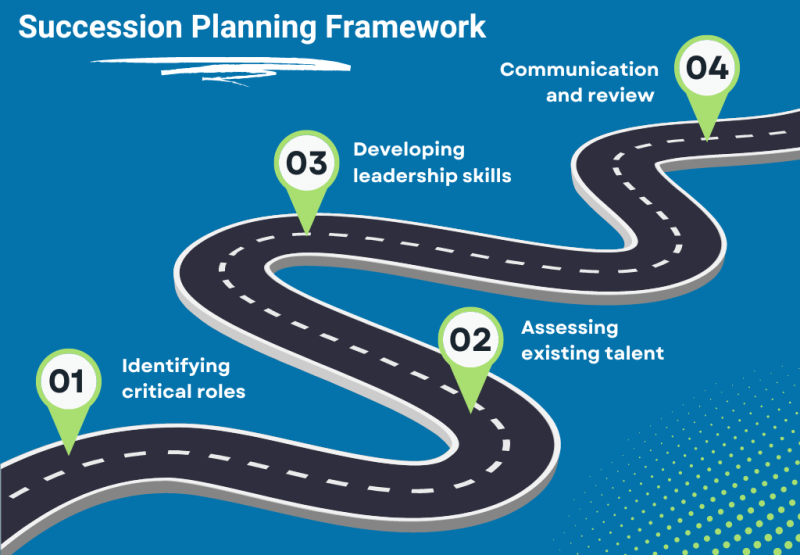
Human resources form the dynamic backbone of an organisation, with constant transitions of personnel being a common reality in today’s corporate landscape. Ensuring the seamless promotion or hiring of qualified individuals to fill vacant positions is paramount for the continuity and triumph of a business. This strategic process of identifying critical roles and cultivating the right talent, whether internally or externally, and training them to step into key positions when required, is known as succession planning.
Introduction
Leadership changes are inevitable due to various reasons like transfers, resignations, retirements, etc. However, many organisations lack a well-founded succession plan for critical leadership positions, despite understanding its impact on continuity.
- According to a Gartner survey, more than a third of HR leaders found it challenging to develop effective senior leaders, while 45% faced difficulties with grooming mid-level leaders. Only 50% felt adequately prepared to lead their organisations in the future.
- Harvard Business Review research revealed that an unsuitable hire for a CEO or other C-suite position can reduce a company’s market value by USD 1 trillion annually. Conversely, selecting the right leader can improve the company’s valuation by 20% to 25%.
The results of these surveys underscore the critical significance of a well-crafted succession plan. Clearly, organisational succession planning is of utmost importance, making it imperative for you to implement a comprehensive plan without delay.
What is Succession Planning and How Does It Work?
Organisational succession planning is a strategic process that identifies and develops internal talent to fill critical roles within an organisation. It is not limited to just the C-suite; it encompasses all levels of the organisation, from technical experts to mid-level managers and executives. The goal is to create a succession planning talent pool that ensures a smooth transition when key positions become vacant.
Succession planning works by systematically evaluating employees’ performance, potential, and readiness for advancement. By proactively identifying high-potential individuals and preparing them for future roles, organisations reduce the disruption caused by unexpected departures and maintain a competitive advantage.
Why is Succession Planning Important?
Organisational succession planning ensures business continuity and stability during leadership changes or sudden departures of key personnel. When a designated successor is prepared to step into a critical role, it prevents disruptions caused by leadership vacancies.
According to the National Center for the Middle Market, businesses with a formal succession plan in place are 25% more likely to experience faster and more sustainable growth.
As such, a well-prepared talent pool for succession planning minimises the negative impact of sudden changes, maintaining a sense of direction and purpose within the organisation. In essence, succession planning acts as the oil that keeps the organisational engine running smoothly without interruption.
Key Terms around Succession Planning
Succession planning is a critical process that ensures an organisation’s success by identifying and developing talent for key roles. Several key terms play a vital role in effective succession planning. Let us explore these terms to understand their significance and how they contribute to building a future-ready workforce.
- Succession Readiness: The state of preparedness of an organization in terms of having identified and developed potential successors for key positions.
- Bench Strength: The depth and quality of talent available within an organization for filling key leadership positions.
- Career Pathing: The process of mapping out a clear career path and growth trajectory for employees within the organization.
- Leadership Assessment: The evaluation of potential successors’ skills, competencies, and readiness for taking on leadership roles.
- Leadership Transition: The process of transferring leadership responsibilities from one leader to another during succession planning.
- Retention Strategy: A plan to retain and keep high-performing employees within the organization to prevent talent drain.
- Talent Pipeline: A pool of qualified and potential candidates who are being developed and groomed for future leadership roles in an organization through succession planning.
- High-Potential Employees: Employees who have been identified as having the potential and ability to take on leadership roles in the future through succession planning.
- Potential successors: Individuals who have the skills, experience, and potential to fill key positions in an organization.
- Contingency planning: A plan for dealing with unexpected events that could disrupt the succession process.
- Exit strategy: A plan for how an organization will replace key personnel who are retiring or leaving the organization.
The High Cost of Poor Succession Planning
Succession planning is not merely a reactive solution to filling vacancies but a proactive approach to ensuring an organisation’s long-term success. While it is never too early to start succession planning, certain triggers necessitate immediate action:
- Impending retirement – when senior leaders or key contributors are approaching retirement age, creating a succession plan becomes imperative.
- High turnover – if an organisation faces higher-than-usual turnover rates, having a succession plan can counter the impact of losing valuable employees.
- Organisational expansion – as companies grow and take on new ventures, having a talent pipeline in place ensures that competent leaders are ready to drive growth.
The consequences of poor succession planning, however, can lead to dire consequences. When organisations lack a clear strategy to develop future leaders, they expose themselves to several risks:
- Leadership vacuum – without a designated successor, leadership transitions can be chaotic, leading to a loss of direction and decreased employee morale.
- Loss of knowledge – departing employees take their knowledge and experience with them, potentially leaving critical roles without proper guidance.
- Talent drain – a lack of career growth opportunities can prompt high-potential employers to seek better prospects elsewhere.

What is a Succession Planning Framework?
A well-designed organisational succession planning framework is the backbone of any successful talent management strategy within an organisation. This structured approach ensures the identification, assessment, and development of the right individuals to fill critical roles when the need arises. Let us delve further into each key element of the succession planning framework.
According to a report by SHRM, organizations with effective succession planning are 2.5 times more likely to be successful in their talent management efforts, leading to greater organizational growth.
Identifying critical roles
The first step is to identify the vital positions for the organisation’s smooth functioning, growth, and success. These positions often include key leadership roles, specialised technical roles, and other critical positions that significantly impact business performance. Recognising these essential roles can help organisations to prioritise their efforts and allocate resources to develop suitable successors for each of them.
Assessing existing talent
Assessing existing talent goes beyond performance reviews and considers employees’ potential and readiness to take on higher responsibilities. Various assessment tools, such as competency-based evaluations, 9-box grid, and 360-degree feedback, can help identify high-potential individuals who are suitable candidates for future leadership positions.
Developing leadership skills
Targeted training, coaching, and mentoring programs can help to nurture and enhance the leadership skills of these high-potential employees. Leadership development initiatives can focus on improving critical competencies, such as decision-making, strategic thinking, communication, and problem-solving. In doing so, organisations ensure a robust pipeline of capable leaders ready to step in when needed.
Communication and review
A successful organisational succession planning framework requires constant communication and review to ensure that the framework still aligns with the organisation’s overall business goals and objectives. These steps include:
- Effective communication with employees about the significance of succession planning in career development fosters a positive and supportive culture.
- Succession reviews to monitor the potential successors’ progress and development to ensure they stay on the right track.
- Continuous evaluation and adjustment to accommodate changing business needs and individual performance.
- Developing succession contingency plans in case of unexpected changes or emergencies to ensure preparedness and minimise disruptions.
4 Benefits of Succession Planning
There are several advantages for both employers and employees to having a formalised succession plan in place. Here are four benefits that explain why succession planning is important:
Reduces negative impact of sudden leadership changes
The sudden departure of key personnel can create significant disruptions. A well-executed succession plan can help companies be better prepared by identifying and grooming potential successors to step into mission-critical roles seamlessly. Having a clear plan in place for the future reduces the time taken to fill the vacant role while alleviating concerns among employees and external stakeholders.
A study by Deloitte found that organizations with a well-executed succession planning process have a 31% higher employee retention rate, resulting in cost savings and increased productivity.
Provides opportunity to identify potential leaders
Succession planning establishes a talent pipeline by identifying high-potential employees with the right skills and leadership qualities. Nurturing these individuals fosters a growth culture, boosting morale and loyalty while reducing the risk of talent loss to competitors. Employees see a clear path for career advancement, enhancing engagement and commitment to the company’s vision and values.
Mitigates talent shortages and skill gaps
In today’s dynamic business environment, skill requirements change rapidly, creating talent shortages that hinder growth and innovation. Proactive succession planning helps companies address these gaps and prepare for the future. By identifying crucial skills and investing in training programs, companies can equip their workforce with the necessary capabilities, reducing dependence on costly external hiring.
Preserves knowledge and expertise
Succession planning preserves valuable knowledge and expertise as experienced employees retire or leave the organisation. This transfer benefits younger employees and makes outgoing employees feel valued. Furthermore, retaining this knowledge safeguards against disruptions during leadership changes, as well-prepared successors maintain business continuity and informed decision-making.
3 Succession Planning Best Practices
Succession planning is a strategic process that requires careful consideration and implementation of best practices to ensure its effectiveness. Let us explore each best practice in detail.
Create succession plans to include technical roles
Technical experts play a pivotal role in driving innovation, maintaining core operations, and ensuring organisational efficiency. Identifying potential successors for technical positions ensures that specialised knowledge and skills are preserved and passed down to the next generation of employees. In doing so, organisations can prevent skill gaps and maintain a steady flow of talent within these critical areas.
Be open to having more than one successor
Flexibility is key in succession planning, especially when it comes to identifying successors for key roles. A single successor may not possess all the required qualities or skillsets. Embracing the possibility of having multiple successors for a single role allows the organisation to adapt to changing circumstances and evolving business needs and reduces the risk of being caught off guard.
Make succession planning part of your workplace culture
Succession planning that is ingrained in the organisation’s culture and values promotes a culture that prioritises talent development, growth, and internal advancement. Encourage employees to take ownership of their career paths and become more invested in their own development. Organisations that actively support employee growth and development are more likely to attract and retain top talent.
Key Takeaways
Organisational succession planning is a proactive strategy that emphasises talent development and the identification of future leaders. Implementing a succession plan allows organisations to plan ahead, reduce expenses linked to external hiring, and enhance the company’s appeal to potential recruits. Here are the key takeaways from this blog:
- Succession planning is a business strategy for passing leadership roles and other mission-critical roles to one or more other successors.
- The first step in succession planning is to identify the critical roles in the organisation and assess the existing talent pool to identify potential successors. This will help you to prioritise your efforts and allocate resources accordingly.
- Once you have identified potential successors, you need to develop their leadership skills through training, coaching, and mentoring. You should also create a succession review process to track the progress of potential successors and make sure they are on track for success.

Frequently Asked Questions (FAQs)
What is succession planning in HR?
Succession planning in HR is a strategic process that involves identifying and developing potential successors for key positions within an organisation. It aims to ensure a smooth transition of leadership and critical roles when current employees retire, leave the company, or are promoted to higher positions.
Who is responsible for succession planning?
Succession planning is a joint responsibility that involves HR professionals, senior management, and leadership teams. HR plays a central role in designing and implementing the succession planning framework, while senior leaders and managers actively participate in identifying and developing potential successors within their respective teams.
What are the factors affecting succession planning?
Several factors can influence the effectiveness of succession planning, including the organisation’s size, industry, culture, leadership commitment, availability of high-potential talent, and the overall economic and business environment.
Why does succession planning fail?
Succession planning can fail due to various reasons, such as inadequate leadership support, lack of a comprehensive and structured succession planning framework, unclear or unrealistic expectations, insufficient focus on talent development, and not aligning the plan with the organisation’s strategic objectives.
What is the risk of loss in succession planning?
The risk of loss in succession planning refers to the potential negative consequences of not having a well-prepared successor to fill critical roles when a current employee departs. This risk can lead to disruptions in leadership, loss of institutional knowledge, talent shortages, and decreased organisational stability.
What is an example of a failed succession plan?
An example of a failed succession plan could be when a company’s CEO unexpectedly resigns, and there is no suitable successor identified or groomed to take over the role. As a result, the company may struggle to find a capable leader, causing uncertainty and impacting the organisation’s performance and reputation.
What is the most critical step in a succession planning process?
The most critical step in a succession planning process is the identification and development of potential successors. Accurately assessing employees’ performance, potential, and readiness for advancement is crucial in building a strong talent pipeline to fill key roles in the future.
What is the biggest challenge in succession planning?
9-box succession planning is a talent assessment tool that categorises employees into a 3×3 grid based on their performance and potential. The grid helps identify high-potential individuals (top-right quadrant) who are strong performers and capable of taking on more significant responsibilities in the future, guiding succession planning efforts.
Page Contents







